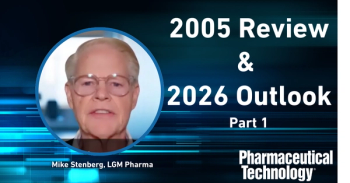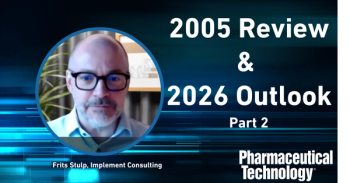
PTSM: Pharmaceutical Technology Sourcing and Management
- PTSM: Pharmaceutical Technology Sourcing and Management-05-09-2008
- Volume 4
- Issue 5
Will REACH Reach the US?
Congress is considering proposing a new chemical policy similar to the European Union’s REACH (Registration, Evaluation, Authorization, and Restriction of Chemicals) regulation. Batch and custom manufacturers weigh in on the debate.
A regulatory storm is beginning to brew as Congress held hearings in late April to discuss oversight of the toxic chemical policies of the
Provisions of REACH
REACH came into force in the European Union on June 1, 2007, with the goal of establishing a uniform system for assessing the risk posed by new and existing chemicals. REACH requires EU-based manufacturers and EU-based importers doing business, directly or indirectly in Europe, to register chemicals and their uses with the newly created
The aim of REACH is to create a single system for “existing” and "new" substances. Substances are classified as nonphase-in substances (those not produced or marketed prior to the entry into force of REACH) and phase-in substances [substances listed in the European Inventory of Existing Chemical Substances (EINECS) or those that have been manufactured in the EU, but not marketed, in the past 15 years]. Approximately 30,000 phase-in substances (excluding intermediates) are expected to be registered during REACH's 11-year implementation (1).
Manufacturers and suppliers are facing the first critical phase in REACH implementation. Preregistration is from June 1, 2008, to Dec.1, 2008, and full registration is required between 2010 and 2018, depending on the tonnage produced or imported into the EU on an annual basis (1, 2).
To preregister an existing compound, the name of the compound, the Chemical Abstract Service (CAS) number, the EINECS number, the name and address of the registrant, and the tonnage must be reported to the European Chemicals Agency in Helsinki (1).
Compliance with REACH is an important consideration for chemical manufacturers and suppliers, including those that supply the pharmaceutical industry. The REACH regulation exempts substances used in medicinal products that fall within the scope of Regulation 726/2004 (centralized procedures), Directive 2001/82/EC (veterinary use), and Directive 2001/83/EC (human use) (1–3). Although a given substance used in a pharmaceutical may be exempt, if the same substance is used in a nonpharmaceutical application, registration under REACH for that substance is required. It is the responsibility of the producer or importer to assess if the substance is used for medicinal or nonmedicinal products (2). Pharmaceutical companies must consider the risk to their supply chain as a producer’s or importer’s failure to preregister or register given substances could affect the continuity of supply of ingredients (3).
Congress considers US version of REACH
Now, the question before the chemical and pharmaceutical industry is whether a REACH-like initiative will take hold in the US. This matter came up as part of oversight hearings on EPA’s toxic chemical policies held by the Senate Committee on Environment and Public Works in late April.
In her opening comments, Committe Chairman Barbara Boxer (D-CA) said there is a need to develop a better policy for regulating hazardous chemicals. “A close look at the EPA’s toxic chemical policies makes clear that improvement is necessary if we are to ensure that dangerous chemicals are properly regulated,” said Boxer. “EPA regulates toxic chemicals in the environment under several laws. The overall toxic chemicals law, the Toxic Substances Control Act, or ‘TSCA,’ was adopted in 1976 and was supposed to help assure that toxic chemicals would be restricted or banned if they were hazardous. But in essence, TSCA puts the burden on the government to prove a toxic chemical is a risk. That is unlike the European program, called REACH. REACH puts the burden on the chemical industry-where it should be-to show that their chemicals are safe.”
SOCMA voices opposition
The
SOCMA pointed out that the committee has not yet proposed legislation to mandate a chemical policy similar to REACH, but in a preemptive strike, urged the committee not to do so.
“In our view, existing EPA regulations and voluntary initiatives are sufficient, and far more appropriate than REACH, to control possible hazards and still preserve the sustainability of America’s third largest manufacturing industry, ” said Jim DeLisi, president of
Others weigh in on debate
Other government agencies, notably EPA and the
EPA's view. He said that EPA has used TSCA to review more than 47,000 new chemical submissions and has taken regulatory actions, such as requirements for additional testing or restrictions on more than 2000 of these chemicals and has withdrawn an additional 1746 new chemical submissions. Since the passage of TSCA, more than 21,000 new chemicals have gone into production and been added to TSCA for a total of 83,000 chemicals on the inventory. EPA has collected health and safety data on 2200 high-production volume (HPV) chemicals,which account for more than 93% of organic chemical production volume that EPA tracks for the TSCA inventory.
“Overall, I believe that TSCA provides broad authority for the agency [EPA] to adequately control new and existing chemicals and to address emerging chemical issues as they arise,” said Guildford.
EPA is also working with Mexico and Canada under the Security and Prosperity Partnership to strengthen the management of chemicals in North America. The US is committed by 2012 to complete initial assessments and take needed actions on 6750 chemicals produced above 25,000 pounds per year in the US. This commitment, the Chemical Assessment and Management Program (ChAMP), includes HPV chemicals, those produced at or above 1 million pounds per year, and moderate-volume chemicals or those chemicals produced between 25,000 and one million pounds per year.
“Our efforts under ChAMP will result in greater public health and environmental protection in the US and will also help ensure a more consistent, efficient, and better integrated approach to chemicals assessment and management throughout North America,” said Guilford in his prepared testimony. He added that the 2012 commitment for completing the North American assessment work will also allow the US and EU to share information on their chemical work given the timing of the EU’s registration schedule for REACH, which extends from 2010–2018.
GAO’s view. John B. Stephenson, director of natural resources and environment at GAO also testified before the Senate committee and pointed out key differences between REACH and TSCA. “REACH generally requires that chemical companies develop and provide government regulators information on chemicals’ effects on human health and the environment, while TSCA generally does not,” he said in prepared testimony.
For example, REACH requires chemical companies to provide and in some cases, to develop, information on chemicals’ physical and chemical properties and health and environmental effects for both new and existing chemicals produced over specified volumes. REACH also provides regulators the general authority to require chemical companies to provide additional test data and other information when necessary to evaluate a chemical’s risk to human health and the environment. “In contrast, TSCA places the burden onEPA to demonstrate that data on health and environmental effects are needed before requiring chemical companies to develop the data,” he said.
The GAO was also critical of EPA’s Integrated Risk Management System (IRIS). IRIS contains EPA’s scientific position on the potential human health effects that may result from exposure to more than 540 chemicals. In a March 2008 report, GAO concluded that the IRIS data is at serious risk of becoming obsolete because EPA has not been able to routinely complete timely and credible assessments or decrease a backlog of 70 ongoing assessments. To illustrate that point, GAO said that EPA sent 32 draft assessments for external review in fiscal years 2006 and 2007, but was only able to finalize four IRIS assessments.
Although EPA sought to improve the IRIS, GAO says the agency has not been able to improve the system. “The Congress should consider requiring EPA to suspend implementation of its new IRIS assessment process and develop a process that is responsive to our recommendations for a streamlined process that is transparent and otherwise transparent to our recommendations aimed at improving the timeliness and credibility of IRIS assessments,” said Stephenson in a prepared statement.
References
1. P.Van Arnum, “A Changing Path in Global Sourcing,” Pharm. Technol. 34 (3) 82–87 (2008).
2. H. Schoolderman, “REACH and its Impact on the Chemical and Pharmaceutical Supply Chains,” presented at DCAT Week 2008 (New York).
3. P. Taylor, “Pharmaceutical Ingredients-The View from the EU,” Pharm. Technol. 34 (4) 84–85 (2008).
Articles in this issue
over 17 years ago
Weak Link in the Pharmaceutical Supply Chainover 17 years ago
Globalizing Drug DevelopmentNewsletter
Get the essential updates shaping the future of pharma manufacturing and compliance—subscribe today to Pharmaceutical Technology and never miss a breakthrough.




